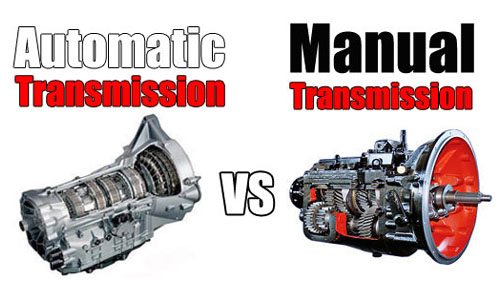
MANUAL TRANSMISSION
Manual transmissions have a more mechanical approach in transferring power i.e. directly. The time between clutch open and clutch closed is really short and when the clutch is closed there are no losses except the minimal ones in the gears. Finally, there’s the element of human judgment which has traditionally been far better than the programming of the automatic cars’ computers (or mechanisms in the case of pre-computer cars) at picking the optimum time and manner of switching gears.
AUTOMATIC TRANSMISSION
With automatic transmissions, you are spinning a turbine in oil (that’s what’s inside a torque converter) which produces considerable losses in the transition between gears, though much less so once the car is up to speed. Also, it has a transmission oil pump that must be turned, also eating away your energy. Finally, automatic transmissions have usually had fewer gears than manuals which means the engine doesn’t run in its optimum efficiency band as often (more gears mean more time in that region).

Sometimes, manuals are better than automatics in terms of fuel efficiency, but not always.
First, let’s understand what makes a transmission fuel efficient:
- Speeds/gearing – The more speeds you have, the more efficient you can be (generally speaking). A lack of speeds plagued automatic transmission efficiency up until the last 15 years or so, when 5, 6, 7, and even 8 speed automatics hit the market. Prior to that time, manuals had more speeds, so they tended to be more efficient.
- Efficient gear selection – It’s not enough to have a lot of gears; you have to know which gear to use when. A competent – yet fairly average – driver with a manual transmission can usually pick the right speed for decent efficiency. Automatic transmissions lacked that ability until fairly recently (last 15 years or so), when ‘gear logic’ algorithms became much better at controlling automatic transmissions.
- 100% engagement – The “old style” of automatic transmissions that most of us are familiar with lacked something called a lock-up torque converter. This old style tried to connect a driveshaft to a flywheel using a fluid coupling, which was inefficient. However, all modern transmissions utilize lock-up torque converters (and have since the 80’s), which form the same physical connection between the flywheel and the drive shaft as a manual transmission. The only time that a fluid coupling comes into play is during gear changes, which automatics can complete every bit as quickly as stick shifts (when programmed to do so).
SOURCE: www.google.com www.quora.com
